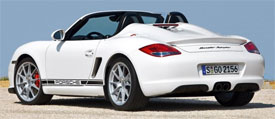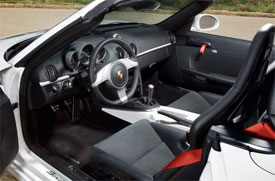2011 Porsche Boxster Spyder
Ever since the brash Cayenne utility hit dealers in 2003, Porsche purists have been understandably uneasy, and with the arrival of the front-engine, four-door Panacea earlier this year, perhaps more so now than ever. But the new Boxster Spyder should be reassuring. With bare bones styling from the iconic 550 Spyder, it’s a 100% classic, but modern, Porsche.
The Boxster’s basic sports car shape is becoming iconic in its own right, but the 2011 Porsche Boxster Spyder cranks it up a notch. Carrera GT-style twin-hump fairings aft of padded roll bars replace the Boxster’s simple deckled. A nicely done stoplight bridges the gap between the fairings.
And for even more fun, a Spartan two-piece manual soft-top gives the Boxster Spyder a definite ‘50s speedster look. And those vintage rocker panel stripes, especially on our sleek black tester, are easily as cool as the ones you get on the 911 GT3 RS. The stripes connect lightweight 19-inch alloy wheels that are unique to the Boxster Spyder.
The Spyder’s front fascia gets only a subtle freshening from the regular Boxster. While, out back, there’s a fixed spoiler and rear fascia borrowed from the Boxster S. But the Boxster sits 8/10ths of an inch lower than the S, and is 176 pounds lighter. Without the power top, and with new aluminum doors and trunk lid, the Spyder is the lightest of current Porsches.
Top down reveals much of the same cozy two-seat cockpit we’ve come to expect in a Boxster. But a closer look reveals red seatbelts, and more weight saving details like GT3RS-style pull-strap door releases, doors stripped of their storage bins, and a gauge cluster stripped of its shroud.
 Seriously track-ready Alcan Tara-trimmed, well-bolstered bucket seats prove more comfortable than they have any right to be. Radio and cupholders are no-cost options, but you’ll have to pay for the privilege of A/C. Like any Boxster, there’s meager trunk space split front and rear, displacing 9.9 cubic feet, total.
Seriously track-ready Alcan Tara-trimmed, well-bolstered bucket seats prove more comfortable than they have any right to be. Radio and cupholders are no-cost options, but you’ll have to pay for the privilege of A/C. Like any Boxster, there’s meager trunk space split front and rear, displacing 9.9 cubic feet, total.
The sole engine is a direct-injected 3.4-liter horizontally opposed six borrowed from the tintop Cayman S. Output is the same, at 320 horsepower and 273 pound-feet of torque. And we’ve gotta say, the Spyder’s exhaust note is pitch-perfect.
A six-speed manual transaxle is standard, but Porsche’s excellent seven-speed dual-clutch PDK automatic is a worthy, quick-shifting alternative. Both transmit power through a mechanical locking differential.
Running through our manual Spyder’s precise ratios at the track resulted in a 5.1-second sprint to 60. That’s the same as the last Boxster S we tested. A result we blame on our tester’s heavy option list. But the quarter mile arrived quicker—13.5 seconds at 106 miles per hour, even with an unavoidable last-minute shift into fourth gear.
The Spyder was much happier in the slalom. The Boxster’s mid-engined layout allows near perfect 50/50 front-to-rear weight distribution, and the Spyder adds to that a lower center of gravity, not to mention tires pumped to a lower PSI for more grip. The high-speed lane change couldn’t faze this chop-top Boxster, either. Inputs and outputs were near-telepathic. The Spyder is the best handling production Porsche we’ve ever driven.
 Braking was also impressive, with stops from 60 averaging a concise 113 feet with firm, short pedal travel and very little nosedive. Credit for all the fade-free stopping goes to our Spyder’s large rotors and four piston calipers.
Braking was also impressive, with stops from 60 averaging a concise 113 feet with firm, short pedal travel and very little nosedive. Credit for all the fade-free stopping goes to our Spyder’s large rotors and four piston calipers.
The Boxster Spyder’s short, stiff springs, anti-roll bars, and dampers tuned to near bone-jarring levels of sportiness never let you forget that this car is most at home on the track.
Government fuel economy ratings for the Boxster Spyder are as good or better than its less focused Boxster stablemates. The automatic rates 20 mpg city/29 highway, while the manual rates 19 city/27 highway. We averaged a respectable 23.9 miles per gallon on premium gas.
Including destination, the 2011 Porsche Boxster Spyder starts at $62,150. That’s four grand more than the much better equipped S. But then the Spyder is much rarer.
So, less car, but more performance, and more head turning, for more money. That’s the Porsche way, and we can’t help coming back for more. Plus, the 2011 Porsche Boxster Spyder is a total reassurance that Porsche is still committed to building true, and cozy, sports cars.
Specifications
- Engine: 3.4-Liter Six
- Horsepower: 320
- Torque: 273 Lb Feet
- 0-60 MPH: 5.1 Seconds
- 1/4 Mile: 13.5 Seconds @ 106 MPH
- 60-0 MPH: 113 Feet
- EPA: 19 MPG City/ 27 MPG Highway
- Mixed Loop: 23.9 MPG
2024 Toyota Land Cruiser
Toyota’s Go Anywhere Globetrotter Returns To U.S.
Every once in a while, we all need a reset. A time to get back to basics and prioritize the things that really matter. Well, for the Toyota Land Cruiser that time is now. So, let’s find out if that means bigger and better things for Toyota’s iconic off-roader.
The Toyota Land Cruiser’s status among the global off-road community is legendary, and it’s hard to imagine there’s any corner of the earth where a Land Cruiser hasn’t kicked up a little dust or mud. Well, 2024 sees the return of the Land Cruiser to the U.S. market after a 3-year hiatus, getting a major reset for the journey.
The reset comes mostly by no longer being based on the large three-row “300-series” chassis, but a new version of the smaller “200-series,” now known as the J250. As with the latest Tacoma, it uses the Tundra pickup’s full-size steel frame.
While the main Land Cruiser model, which goes by simply Land Cruiser, is packed full of luxury and convenience features, there is also a stripped-down model known as the 1958, honoring the first year the Land Cruiser made landfall here in North America. And it is that 1958 we have here, and we were glad to see it, as it also celebrates the original’s back-to-basics approach as a blank canvas for you to personalize as you tackle more and more adventures.
Not that it’s fully stripped down, as 8-inch touchscreen infotainment, a 7-inch full-color multi-information display, and automatic climate control are still standard. Plus, some seriously durable materials, and great heated cloth front seats that throw off some get serious 1990s Tacoma vibes.
But outside, there’s a definite lack of flashy trim and basic looking 18-inch wheels with Yokohama Geolander all-season tires; plus, big chunky bumpers and tilt-up back glass, which is a rarity that we appreciate. Though there is a little too much plastic in places that are sure to see some abuse if you do any significant off-roading.
It even feels a little rough around the edges, but for us it just adds to the rugged old-school utility vibe in a good way.
We did just that, both here in the Mid-Atlantic as well as in the California desert; and while there are some tech-forward driving aids, the actual hardware is in most cases plenty to get things done. That includes standard full-time dual-range four-wheel-drive, locking center and rear diffs, and 8.7-inches of ground clearance. A front stabilizer bar disconnect is also available to allow for increased articulation.
Who needs a V6 or even a V8 when you’ve got Toyota’s i-FORCE MAX setup at your disposal with 326 horsepower and 465 lb-ft of torque coming from a 2.4-liter turbo-four with an electric motor sandwiched between the engine and its eight-speed automatic transmission. Low speed torque delivery is impressive. It even feels a little rough around the edges, which may be a turn off to some, but for us it just adds to the rugged old-school utility vibe in a good way.
And it certainly feels quicker than an off roader needs to be, with an instant torque dump as soon as we eased on the throttle at our Mason Dixon test track; helping us get to 60 in 8.1 seconds and through the quarter-mile in 16.3 seconds at 86 mph. Considering the Land Cruiser’s terrain conquering mission, it behaved quite well in our handling course; it was plenty responsive to inputs, with less body roll than we expected and plenty of grip from the tires. The steering was light and quick but as expected didn’t provide much feel. Other than significant nosedive, braking performance was exceptional. Only 107-feet to panic stop us from 60 mph.
With the shift to the smaller size, there’s no more third row available, and cargo capacity now comes in at 46.2 cubic-feet with a max of a still healthy 82.1. Now, the best part of the Land Cruiser’s return is the entry price of $57,445. That’s about 30-grand less than what the last Land Cruiser went for back in 2021.
Whether it’s over the top fashion trends, mullets, or zombies; just when you think they’re dead, they come roaring back to life. Of course, we’re much happier to see the resurrection of this 2024 Toyota Land Cruiser than any of those things. Toyota is one brand that still recognizes the value of full-framed rugged rigs and has also acknowledged that sometimes less really is more. The Godfather of Toyota off-roading is back and better than ever.







